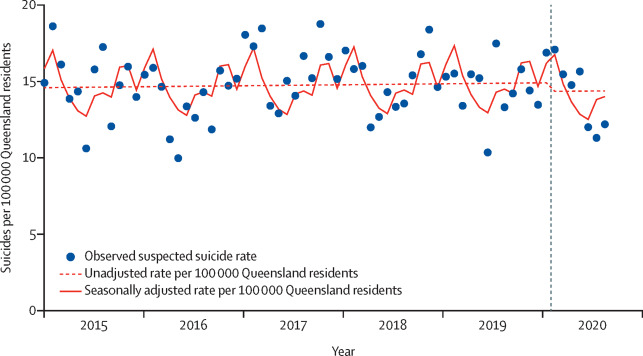Has the COVID-19 Pandemic Increased the Suicide Rate?
Author: Haiyi Liu

COVID-19 is one of the most newly appeared, unexpected, and severe pandemics in the world. According to World Health Organization updates, until February 2021, it has resulted in 103,362,039 confirmed cases and 2,244,713 confirmed death. Although previous studies have shown the effect of a disease outbreak on death by suicide, there was no strong evidence to prove that this unusual outbreak will lead increased death by suicide.
To further explore the relationship between the COVID-19 pandemic and suicide death, a group of scientists has proposed a level change a priori as an impact model. Based on interrupted time-series analysis design and negative binomial regressions, the researchers obtained the monthly suspected suicide rate and potential suicide motives. The database used in this study is the interim Queensland Suicide Register (iQSR), a state-wide real-time suicide surveillance system in Queensland, Australia.
In general, after the Public Health Emergency Declaration on January 29th 2020, in Queensland, there is no evidence showing a strong correlation between the COVID-19 pandemic and suspected suicide during the next 7 months. This is especially evident with unadjusted monthly rates. For example, from 2015 to the Public Health Emergency Declaration, 3793 suspected suicides are recorded, after the declaration to August 31, 443 suspected suicides were recorded. The Poisson regression and negative binomial regression also shows that the COVID-19 outbreak produced no effect of COVID-19 on suicide. In 36 suspected suicides influenced by COVID-19, most of them were caused by unstable mental health statuses such as stress and anxiety and dramatically changed social environment related to employment, health care, and financial problem.
In the paper, the researchers mentioned: “the need for government to maintain the monitoring and reporting of suicide mortality in real life”. Indeed, considering social stability and humanitarian concern, it is reasonable for the government to prevent suicide. However, as the potential effect that COVID-19 has on death by suicide is by affecting vulnerable groups and the economy, it is more effective to solve the problems such as reduced social opportunities, extended quarantine isolation, and economic hardship rather than official psychology intervention. Speculation was made that COVID-19 has the potential to increase mental health issues but compared to providing mental health support under the limited condition of public health resources, finding the sources of the problem and solving it fundamentally may also be a good choice.
References:
Figure retrieved from Leske, S., Kõlves, K., Crompton, D., Arensman, E., & De Leo, D. Real-time suicide mortality data from police reports in Queensland, Australia, during the COVID-19 pandemic: an interrupted time-series analysis. The Lancet Psychiatry (2021). https://www.thelancet.com/journals/lanpsy/article/PIIS2215-0366(20)30435-1/fulltext
Stuart Leske, Kairi Kõlves, David Crompton, Ella Arensman, Diego de Leo. (2020). Real-time suicide mortality data from police reports in Queensland, Australia, during the COVID-19 pandemic: An interrupted time-series analysis. Lancet Psychiatry, 58–63. https://doi.org/10.1016/ S2215-0366(20)30435-1